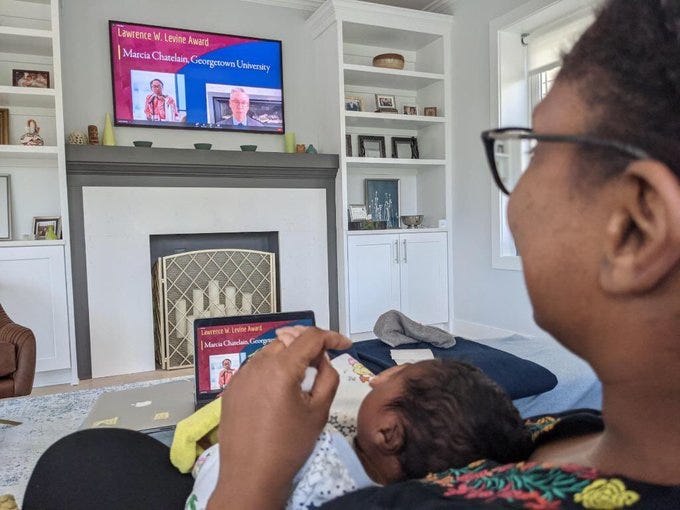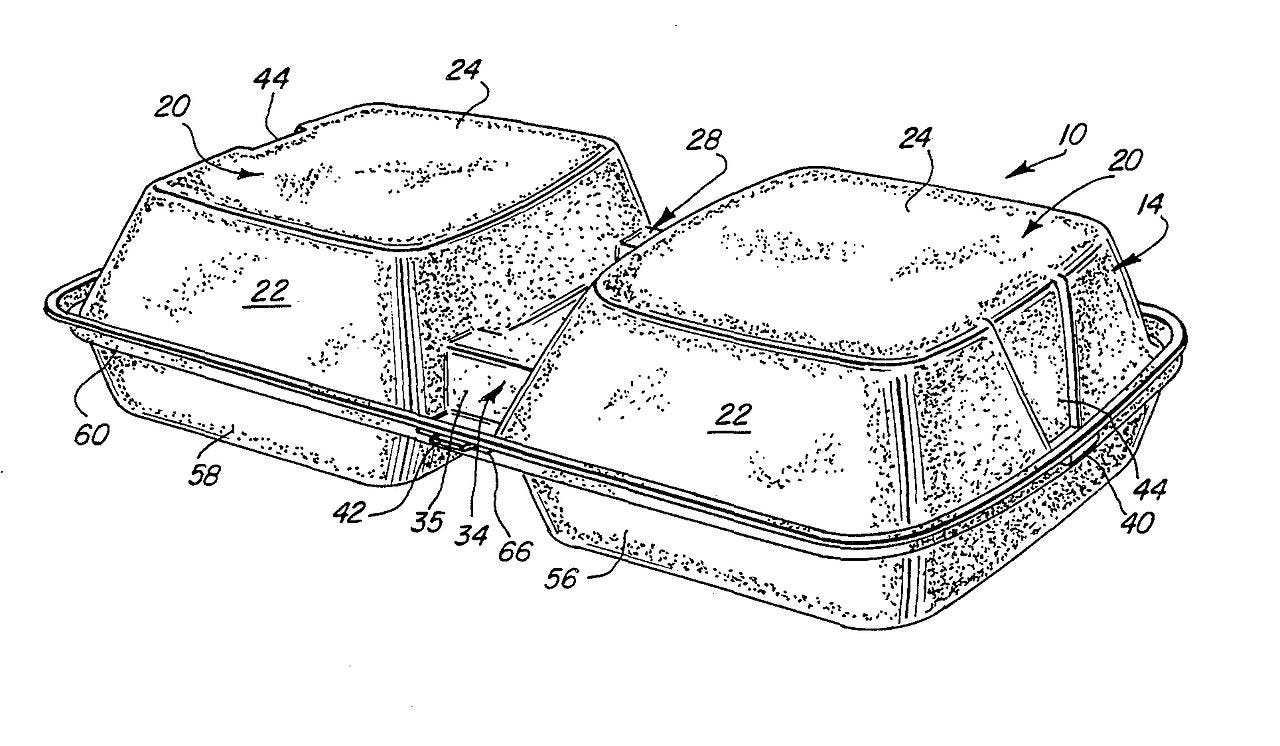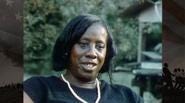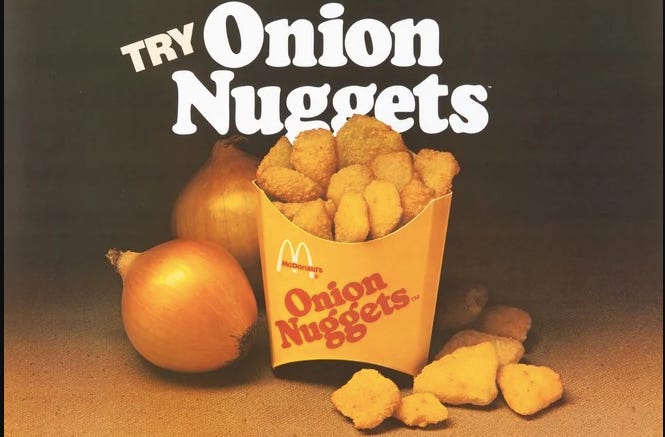Hello Class,
I hope you had a great week. For the subscribers-only newsletter this past week, I shared the exciting news that I’m a new mom! I adopted a baby boy on April 1 and I’ve been enjoying learning all about babies—their developmental stages, the strange tools they need for their grooming and care, and I’m appreciating more and more the incredible ways that parenting has made me appreciate my life’s work. I adore my students, and I’ve always imagined the joys of parenting young adults, like the ones I get to connect with through teaching. Although my son is a long way until he is in that 18-22 demographic, I hope we will have the same kind of fun learning together that I have had with students over the past 13 years of my career as a professor.
In addition to learning just how little sleep I can get, I spent some time talking about my book Franchise: The Golden Arches in Black America, and celebrating lots of good news. The book was the recipient of the Lawrence Levine Award for Cultural History from the Organization of American Historians, and I was also given an Honorable Mention for the organization’s James A. Rawley Prize for the History of Race Relations. The best part of a virtual awards ceremony, is that my baby could join me. He was really impressed by the other books, projects, and scholars honored at the ceremony. We also celebrated Franchise making the shortlist for the 2021 Art of Eating Prize.
This upcoming week is a lot quieter, and I’ll be giving a book lecture for Baltimore’s Reginald Lewis Museum of Maryland African American History and Culture.

During the research process for Franchise, I spent a lot of time combing through McDonald’s advertising, as well as other fast food companies, to better understand how the industry marketed its products to African American consumers. One of my favorite research destinations was New York City’s Paley Center for Media, which houses an excellent collection of McDonald’s TV ads. Although there has been a long history of market segmentation in the advertising industry that dates all the way to the early 20th century, the 1970s was a moment of great enthusiasm for targeted marketing. With the passage of the Civil Rights Act of 1964, growing affluence among the Black middle class, as well as greater support for Black-owned business, various industries decided to invest in selling goods and services to Black customers. The fast food industry was particularly adept at hiring experts on Black consumers, contracting with Black-owned market research and advertising firms, and hiring Black spokespeople to shill their burgers, milkshakes, and everything in between. Who doesn’t love a celebrity? Here are five of my favorite, star-fueled advertising campaigns from McDonald’s.
Patti Labelle, McDonald’s, 1990
Where to begin with this one? An R&B Diva. An outstanding wig. And, a play on her name. Patti LaBelle graced audiences with her Double Patti Combo ad to promote a double-decker Quarter Pounder in the 1990s. Although Miss Patti is now known as the purveyor of pre-made pies, in the 1990s, she was in the midst of a notable television acting career. She played the role of Mrs. Adele Wayne, mother of Dwayne, on the NBC hit “A Different World,” and she later anchored the short-lived “Out All Night,” about a singer (not a stretch) turned nightclub owner. This one-season wonder starred Morris Chestnut and Vivica A. Fox. Both shows were part of a Black Renaissance in network television in the 1990s (if the Renaissance involved a laugh track), when a series of situation comedies were produced to test the ‘crossover’ appeal of Black-led content. In many ways, the advertising industry tried similar strategies in creating commercials and ads featuring Black celebrities that appealed to viewers of all racial backgrounds. Stars like LaBelle, Michael Jordan, and later Lebron James, would prove the Black spokespeople could appeal to non-Black eaters.
Gladys Knight and the Pips, McDonald’s 1986
Before she opened her own chicken-and-waffles outfit, which dramatically closed in 2017 (like family drama, money stuff, raids, accusations galore), the great Gladys Knight leat her vocal stylings to McDonald’s. In 1986, she promoted one of the most 1980s foods of all time—the McDLT. Youngins, gather round for a story of partially why the planet is heating up. The McDLT—a more adult burger with TWO whole slices of tomatoes—promised to keep your burger climate controlled, with a hot side and a cold side. This was innovation in the 1980s—conjoined Styrofoam. Bad for the environment, and kinda bad for America. This went the way of the Betamax a few years after it debuted, and it was gone by 1991.

The patent for the MCDLT carrier. Via US Patent Office. DeBarge, McDonald’s, 1983
Who doesn’t love a family singing group? Everyone’s favorite curly-haired siblings, DeBarge allowed themselves to be miniaturized to sell McDonald’s top menu items in 1984, including a relatively new Chicken McNugget, introduced to the nation a year earlier. The origins of the Chicken McNugget was a really bad idea—an Onion Nugget—that taste testers said gave them gas and failed to bring them the joy that DeBarge brings me. What can you say about something so perfectly 1980s, other than “I like it.”
Willie and Lester, McDonald’s, 1984
Nothing haunts my dreams more than a ventriloquist act. I guess I’m using celebrity broadly here, but Willie and Lester were pretty big in the 1980s. And, I’ll argue that Willie Tyler is pretty important in the larger story of Black performers and ventriloquism, as he was the very first guest of this kind to appear on “The David Letterman Show.” Tyler got his big break on “Rowan and Martin’s Laugh-In” in 1972, and he has essentially worked in comedy for nearly half a century.
Venus and Serena Williams, McDonald’s, 2002
Although the dynamic tennis duo are shilling the Dollar Menu here, I imagine they were paid in far more than a Big and Tasty Burger and the opportunity to meet the Hamburglar. These sisters are no strangers to franchises, and like many Black celebs and athletes before her, Venus’s wealth portfolio includes a few locations of a popular, quick service outlet. Nope, not McDonald’s, but Jamba Juice.
Hope you enjoyed this walk down memory lane!
After more than a year of Zoom teaching, every week creates its own challenges. The verdict in the Derek Chauvin trial coupled with the news of a Columbus (OH) police officer killing 16-year-old Ma’Khia Bryant on the same day sent students, and educators, into a tough, emotional place. A number of schools and communities feared that an acquittal in the Chauvin case would spark the kind of unrest we experienced this past summer. Although a guilty verdict in the case does not come close to honoring the many losses of the Floyd family, the conclusion of the trial allowed for some temporary relief. Then, the news out of Columbus about a teenager killed by police made the Chauvin trial feel like a distant memory. And, regardless of what happens in the world on any given day, if it happens on a school day, we are expected to be present, be focused, and teach our students. How do we do this when the weight of past and present rests on our shoulders, clouds our thinking, and make us feel like our work barely matters?
I don’t have a simple answer to this one, and in many ways, my coming of age as an educator occurred during a similar moment, in which the crisis in Ferguson, Missouri compelled me to think differently about the space I create in the classroom for complex emotions, as well as nuanced learning.
One of the few activities I return to in moments like this require students to reflect with one another on the following questions. I was saddened that Zoom teaching a class of nearly 90 students this term did not allow me to do it. I developed this activity after a grand jury declined to charge Officer Darren Wilson in the killing of Michael Brown in 2014. I found that this exercise was a much better, structured way to acknowledge the difficulty of the moment, rather than an open, conversational free-for-all, which many educators find difficult to lead and manage when such emotional content is brought up in class. So, I developed this ‘day after’ practice for when the news is too much to bear, and the best thing we can do is talk to each other. Feel free to modify for your context. One particularly memorable reflection a student shared with me about this exercise in 2014, was that as a White person, it had never occurred to her that her non-White peers would discuss news about racial injustice at holidays. She was struck in her one-on-one conversations with her peers that there was no possibility of compartmentalization, even for Thanksgiving and Christmas.
Small steps lead to big changes.
For this exercise, have students complete the sentences and discuss with another student. Rotate pairs with each questions.
When I heard the [news event], I dreaded____________________.
When I learned about [news event], I was most afraid to _______________.
I decided that I should talk to my roommate about [news event] in this way_____.
I’m avoiding talking about [news event] with ______________.
The part about [news event] I struggle with the most is____________.
An aspect about [news event] that I’m not sure I have an opinion about is _______.
I think that [news event] makes me more interested in_________.
I think that [news event] makes me more uncertain about__________.
I think that [news event] has forced me to consider_______________.
[News event] has changed the way I_______________________.
Sometime I close these one-on-one sessions with a clip from the “Eyes on the Prize” documentary series about the Civil Rights Movement. I show a clip from the episode “Is this America? 1962-1964” about the Student Nonviolent Coordinating Committee’s Freedom Summer campaign. I highlight this interview with Summer volunteer Unita Blackwell about the importance of people sitting down and talking to each other.

She says:
I remember cooking some pinto beans and that's all we had. And everybody just got around the pot, you know, and that was an experience, you know, just to see white people coming around the pot and getting a bowl and putting some stuff in. And then sitting around talking and sitting on the floor, sitting anywhere because, you know, there wasn't any great dining room tables and stuff that we had been used to working in the white people houses. And go in there and find them all sitting, you know, and everybody sitting and they'd ring a bell or something and tap, and you'd come in and bring the stuff and put it around. But this, you were sitting on the floor and they was talking, you know, and we was sitting there laughing. I guess they become very real and very human, we each to one another.
Let’s remember that our classrooms are often the first, and unfortunately last, place where we can become very real and very human to one another.
Until next time,
Your Favorite Prof





Hi there, Thank you so much for sharing your classroom process during moments like this. As someone who is still coming into my own as an instructor, I truly appreciate it!